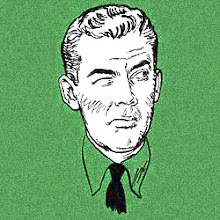 I've mentioned that The Collected Poems of Weldon Kees was published in 1960. When the narrator of Kees' poems is in the third person, he is sometimes given a name - Robinson, whom Kenneth Rexroth described as "modern man at the end of his rope."
I've mentioned that The Collected Poems of Weldon Kees was published in 1960. When the narrator of Kees' poems is in the third person, he is sometimes given a name - Robinson, whom Kenneth Rexroth described as "modern man at the end of his rope." Rexroth (in his review of the book, published in the New York Times on January 8, 1961) added that Kees is only distinguishable from this Robinson by his (Kees') pity. And then, to make things clear: Kees is "Robinson Crusoe, utterly alone on Madison Avenue, a stranger and afraid in the world of high-paying news weeklies, fashionable galleries...high-brow movies," etc.
In 1956, in a letter, Rexroth observed of his friend Kees, that while others "have called themselves Apocalyptics, Kees lived in a permanent and hopeless apocalypse."
Kees worked for a while at Time magazine, where his boss was Whittaker Chambers.
Kees went with Elizabeth Bishop to visit Ezra Pound at St. Elizabeth's hospital in Washington, DC.
Mark Ford wrote in 2004 that Kees "radiated something Bartlebyish." "Why don't you want to be a success?" Truman Capote asked Kees at a party in 1948 (and one can well imagine Capote's tone in asking this).
From a late poem:
If this room is our world, then let
This world be damned.

 Is '60 the moment when the end of the end of the Old Left had been reached and the New Left began to emerge? Is it the final ascendancy, in certain scenes at least, of poetic postmodernity? Surely the publication of Donald Allen's The New American Poetry that year suggests this, but then again--once again--we look back on "New" here and see continuity. The rhetoric of the Kennedy-Nixon contest made much less of a dent than everyone (at the time as well as since) claimed, so one wonders why were such great claims made?
Is '60 the moment when the end of the end of the Old Left had been reached and the New Left began to emerge? Is it the final ascendancy, in certain scenes at least, of poetic postmodernity? Surely the publication of Donald Allen's The New American Poetry that year suggests this, but then again--once again--we look back on "New" here and see continuity. The rhetoric of the Kennedy-Nixon contest made much less of a dent than everyone (at the time as well as since) claimed, so one wonders why were such great claims made?  Had we come to expect "1960" to be truly ubiquitously modern in a way that the 1950s really were not--not quite? And what specifically does "modern" mean in the Kennedyesque talk then and now about the torch being passed to a new generation, etc.? The First Lady really meant "modernist" when Camelotians said "modern." What about the others across the new young cultural leadership? I've been surprised by how frequently the
Had we come to expect "1960" to be truly ubiquitously modern in a way that the 1950s really were not--not quite? And what specifically does "modern" mean in the Kennedyesque talk then and now about the torch being passed to a new generation, etc.? The First Lady really meant "modernist" when Camelotians said "modern." What about the others across the new young cultural leadership? I've been surprised by how frequently the  "Beat movement" was covered in 1960 in the mainstream press. I was expecting a fair measure but I've found tonnage. 1960 was the year when the figure of the beat was beginning to find acceptance, although still 80% of these stories are mocking, rebels-without-cause condescension. For anyone whose analysis made an impact nationally, do these antipolitical adolescents count as part of the "new young cultural leadership"? No, but rather than the two being opposites, they fall along a Continuum of the New American. Now that's a change for '60.
"Beat movement" was covered in 1960 in the mainstream press. I was expecting a fair measure but I've found tonnage. 1960 was the year when the figure of the beat was beginning to find acceptance, although still 80% of these stories are mocking, rebels-without-cause condescension. For anyone whose analysis made an impact nationally, do these antipolitical adolescents count as part of the "new young cultural leadership"? No, but rather than the two being opposites, they fall along a Continuum of the New American. Now that's a change for '60.







